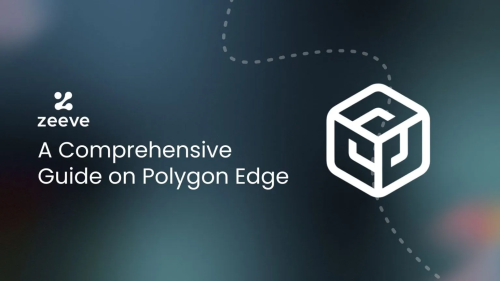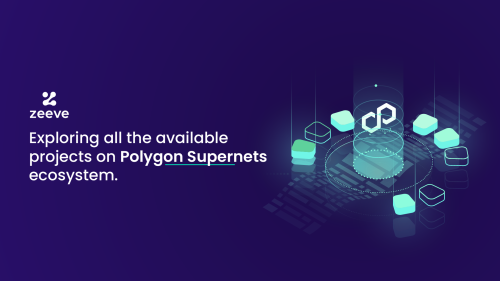
A Comprehensive Guide on Polygon Edge
The problem of scalability has always been one of the bottlenecks to blockchain’s mass implementation. One potential solution to this problem is the development of an application-specific sidechain. Polygon Edge was designed keeping this intention in mind. However, the support for Polygon Edge networks has been officially discontinued by Polygon to encourage projects to upgrade to Polygon CDK.
Through this Polygon Edge guide, we will delve deeper into Polygon Edge – exploring its unique features, advantages, and industry-wide use cases. Also, we will understand how projects can still leverage the Polygon Edge ecosystem to build and manage their use case-specific dApps.

A brief overview of Polygon Edge
Polygon Edge was introduced to enable the creation of high-performing, customizable sidechain kind of blockchains. Networks built with Edge can accommodate higher scalability, transaction throughput, and customizability. This happens due to the usage of a combination of scaling solutions. These solutions include layer-2 scaling techniques like sharding and parallelization.
Edge is an app-specific chain that operates on the Edge consensus client PolyBFT consensus. For this, Polygon Edge Guide, let’s discuss some of the important features:
- The Polygon Edge has done a commendable job of empowering enterprise-grade projects since it was introduced in May 2021. The appchains built with it have great benefits for enterprises. It provides high performance, better autonomy, and superior scalability.
- Edge offers a modular framework that simplifies the blockchain development process of blockchain implementation.
- Developers used Edge to create many high-performance networks. Developers get the option to make tailor-made blockchain networks as there is a provision of customizable virtual machines.
- Edge is also optimized to offer on-chain governance, which makes the network community-driven.
The key offering of Polygon Edge
Polygon Edge offers a range of innovative features that make it stand out in the crowd of other blockchain protocols. Let’s discuss key features for this Polygon Edge Guide:
Flexibility & customizability
Edge supports PoS side chains alongside MATIC staking, and extends the Proof of Scale manner. Edge allows customization of transaction fees and gas tokens and integrates advanced technologies like off-chain transaction processing to improve the network’s overall capacity– whether it’s about security or scalability.
EVM Compatibility
Polygon Edge offers EVM compatibility. This means developers with familiarity with Solidity and Ethereum-based developer tools and frameworks can easily build custom Edge-based solutions. This way, Polygon Edge prioritizes flexibility, adaptability, and streamlined development.
Higher throughput for scalability
With Polygon Edge, the entire blockspace will be dedicated to a single application. Therefore, ensuring a seamless user experience. Also, Edge offers cross-chain interoperability and enhances collaboration across the network. Therefore, Polygon Edge provides higher scalability for blockchain applications. The ecosystem leverages advanced Layer 2 solutions and techniques to ensure high scalability by processing transactions off-chain and settling on the Ethereum mainnet.
Better Security
All the Polygon Edge-based networks offer reliable security to dApps. When Edge was a part of Polygon, it was able to get security from Ethereum and Polygon. Now that its support is discontinued, it was still inherit security from Layer-1 Ethereum. Thus, Edge projects can maintain security for regulatory compliance.
Interoperability
As we talked about the native bridge to the Polygon PoS, it enhances interoperability between Polygon Edge networks. The interoperability further becomes better with the support of many third-party bridges; the bridging lets the network customize plug-ins between different layers.
Native Gas Token
Projects on Polygon Edge benefit from the option to use their own native gas tokens, with customizable fee structures and utility tokens improving the network participation and economy.
Consensus and Governance
Polygon Edge offers exceptional throughput, fast finality, and minimal latency, enabling the development of highly scalable web3 projects. Plus, its on-chain governance feature enhances transparency and accountability.
Smart contract Predeployment and Permissioning
With Polygon Edge, a network can manage the users who can deploy smart contracts. They can use two steps –
1. Whitelist all the smart contract addresses that are eligible to deploy smart contracts.
2. Remove all the addresses from the whitelisted address.
Speaking about Smart Contract Predeployment, instead of manually deploying a smart contract on any chain, users can utilize their existing smart contract of Layer-1. This means Polygon Edge lets users use their Solidity-based Smart Contracts for their Layer-2s built with Edge.
Developer-friendly tools
Polygon Edge offers rich and diverse developer tools, documentation, and resources to support developers for an easy development process. It offers pre-built modules, libraries, and SDKs supporting smart contracts, wallet, and UI development in multiple programming languages so that developers’ preferences are considered.
Cross-chain communication
Polygon Edge is optimized to offer cross-chain communication between Ethereum-compatible networks and other Polygon-based projects. This is done through Chainbridge— a multi-directional blockchain that supports Substrate and EVM-compatible chains. All the data, messages, and assets can be transferred between these chains through Chainbridge.
Better UX
The UX of the Polygon Edge is designed to suit advanced and unique needs of web3 projects. For example, Edge has the relayer-type functionality, which allows Polygon Edge to pay Zero the gas fee. Thus, making the onboarding a frictionless process.

What kind of projects can be built on Polygon Edge?
Polygon Edge platform can benefit a range of industries and users in terms of speed and transaction fees. Let’s discuss some of them in our Polygon Edge Guide:
Web3 Gaming
Many global gaming companies, including Immutable, Mortar, Palm Network, and Square Enix, are part of the Polygon gaming ecosystem that utilized the Polygon Edge ecosystem to build their standalone chain. By doing this, games have more control over their game economy, on-chain governance, and other aspects. Plus, they get the ease to customize their game as per player’s preferences. Now that Polygon has introduced Polygon CDK for building custom Zk-powered chain, most of these projects have migrated to CDK chain, for examples Immutable has launched ImmutableX and Palm Network has launched Zkevm L2 with Polygon CDK.
Defi Projects
Polygon Edge offers unique features for DeFi projects, such as fast transaction times, low fees, and a highly secure environment that makes a DeFi ecosystem more accessible, affordable, and secure. Many DeFi leaders, Avem Finance, SX Network, Canto, and Aavegotchi, have preferred Polygon Edge to launch their application-specific sidechain. However, Canto, SX Network, And Aavegotchi decided to upgrade their project to the Polygon CDK chain to leverage the benefits of rollup technology, validiums, and more.
Enterprise solutions
Polygon Edge is ideal for all kinds of Enterprises— be it supply chain, Gaming, NFTs, Healthcare, or any other sector. For example, Candle Labs, ETM Network, Route3, and SX Network have built their projects with Polygon Edge. However, many of them have already upgraded to Polygon’s ZkEVM and CDK ecosystem. All these web3 projects opted for Polygon Edge to achieve benefits such as significant improvement in the speed of transactions, better security, and customization.
How can Zeeve help you manage/upgrade Polygon Edge Network?
As discussed in our Polygon Edge guide, Polygon has discontinued support for Edge. But, a lot of enterprises and web3 projects are still leveraging or want to continue leveraging the Polygon Edge ecosystem. For them, Zeeve is offering seamless management of their Polygon Edge networks with enterprise-grade, highly scalable infrastructure– complete with ISO 27001, SOC2 Type2, GDPR compliance, and SLA support for up to 99.95% uptime.
Also, Zeeve offers reliable migration assistance, allowing Edge-based projects to upgrade to the Polygon CDK chain seamlessly. Zeeve provides a modular ZK Rollups-as-a-Service (zkRaaS) stack with a range of tools— complete with a no-code deployment tool— Polygon CDK Sandbox. Sandbox is ideal for projects that want to build a CDK chain from scratch without writing smart contracts or any coding.
For more information on how Zeeve simplifies Polygon Edge management or upgrades to Polygon CDK, feel free to connect with our experts. You can drop your queries via mail on this page or schedule a one-on-one call for a detailed discussion.






Responses